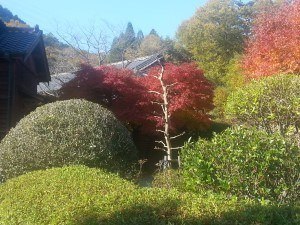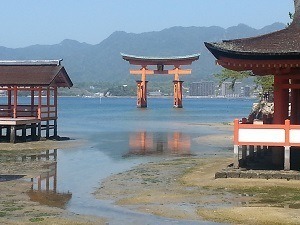Japan Highlights in Plum Blossom Season



A Luxury Tour taking in the Highlights of Japan
For late February and into early March we have put together a customised tour
for two of our guests. The schedule below incorporates many of the
highlights of Japan incorporating some luxury accommodation and some special
activities. (This is a confirmed tour.)
As of October 2017, this tour is currently fully booked. If you would
like to undertake a similar trip to take in the beauty of Japan in the cooler
months of February and early March, please contact us directly. Due to the
luxury nature of this tour we are only accepting a maximum of six people. This
reflects the style of the tour and the personal and small group approach that we
apply to our trips.
Email us at
admin@japancustomtours.co.nz
to discuss your specific dates for arrival and departure.
Schedule (Fully Booked)
Saturday 24th February or 25th February Sunday 25th February Tokyo: We meet
you at Narita or Haneda airport. After clearing Immigration, luggage collection
and Customs, meet at the exit of the arrivals hall. From the airport arrivals we
take the train to Tokyo Station. From the arrival tracks at Tokyo station to the Tokyo Station
Hotel is a few minutes.
Monday 26th February Tokyo: For the first formal day of the tour we suggest starting the
day around 8 a.m. Taking the subway, head to Asukusa and see the Kaminarimon
(?Thunder gate??), Hozomon and pagoda. An array of stalls lines Nakamise Street
(the entrance to this shrine) providing a wide range of souvenirs and snacks on
the approach to Sensoji Temple, the oldest temple in Tokyo (founded 645).
Start with a visit to the Tokyo Metropolitan building for a bird's eye view of
the city from the 45th floor (200 meters up). From there, head to the west side
of Shinjuku to the national gardens (58.3 hectares) including an impressive
green house and some residual cherry blossom. From the gardens, head to the
Golden Gai area of old style bars before seeing Godzilla towering above the
night life area of Kabukicho or visiting the small (but interesting) Samurai
museum.
Tuesday 27th February Tokyo to Nagano: We then head to Ueno which provides some
good options and variety for lunch adjacent to the expansive Ueno Park. The park
also contains several museums (including Tokyo National Museum) and Tokyo Zoo
(the main attraction of which is a giant panda) and the beautiful Tōshō-gū shine
that enshrines the first Shōgun of the Tokugawa Shogunate.
We depart Tokyo in the afternoon for the trip to Nagano (16:42 departure,
arrival 17:46 ? about 220km). This allows for the check-in at the hotel and an
evening meal in the city.
Wednesday 28th February Nagano: After breakfast, we use the express bus to take
us to the Jigokudani Monkey Park. The trip is approximately 45 minutes and
delivers us to Yamanouchi, the access point for our walk to the monkey park.
There is an approximately 2km walk to get to the ?snow monkeys?. Our usual
schedule provides time to watch the monkeys before heading back towards our bus
pick-up point. There is time for lunch at Enza Cafe, which has a good variety of
lunch options.
On the return to Nagano city there is an opportunity to visit the Zenko-ji
temple, founded in the 7th century. The temple houses the first Buddhist image
in Japan (552CE) and the city grew around the temple. Among the interesting
features is the passageway beneath the inner chamber and people search for the
"key to paradise" and numerous important cultural properties.
Thursday 1st March Nagano to Kanazawa: Continuing our journey across Japan's
biggest island (Honshu), we take the Shinkansen train to Kanazawa.
The local Omi-cho fresh food market as across the street from the hotel and
provides a good option for a fresh sushi/sashimi lunch. After lunch visit the
beautiful Kenrokuen Gardens (one of the top three gardens of Japan) and Kanazawa
Castle. The city also boasts the 21st Century Museum of Contemporary Art which
is also an option.
Friday 2nd March Kanazawa to Takayama: Departing Kanazawa, we make the journey
back into the Japanese Alps to Takayama, a small mountain town. The afternoon is
available for exploring the town, its historic/preserved areas or visits one of
the different small museums or temples scattered around the town. Takayama is
famous for its wood-working and its float festival. A visit to the float museum
is a typical stop on our tours.
The famous local dish is Hida beef (similar to Kobe beef) and this is a good
option at a local bbq restaurant.
Saturday 3rd March Takayama to Kyoto: One of the nearby attractions of the area
is the unique steep thatched-roofed houses (gassho style) at Shirakawa-go. We
will use the morning half day bus tour as it is more convenient that getting the
local bus and delivers us back to Takayama town by noon.
After lunch we leaving Takayama on the 1:30 p.m. train we take the scenic trip
back through the mountains to Nagoya and the short leg to Kyoto for an evening
arrival.
Sunday 4th March Kyoto: Visit Nijo Castle (the palace buildings are one the best
surviving examples of castle palace architecture of Japan's feudal era). Due to
the timing, the plum grove at the castle should be in bloom. From Nijo we had to
the "Golden Pavilion" Kinkaku-ji in the north-west of the city which typically
takes us to mid-day.
Travelling by taxi, head to the beautiful Arashiyama district for Togetsukyo
Bridge and enjoy the view across the Oi River (Katsura River downstream of the
bridge). Having a leisurely boat ride on the river is an option. Arashiyama is
also famous for Sagano bamboo grove and its temples.
Monday 5th March Kyoto: Concentrating more on the eastern side of the city there
are many worthwhile locations (avoiding too many temples and shrines) including:
Heian Shrine and its peaceful gardens, and Ginkakuji (the silver pavilion, a
nice but different experience to the golden pavilion), Sanjusangendo with its
1,000 hand carved statues or Kiyomizudera temple. We also usually visit the very
accessible Fushimi Inari Shinto shrine with its famous 10,000 torii gates. (The
actual schedule might be decided closer to the time depending on your
preferences and interests.)
Tuesday 6th March Kyoto: To experience one of the most important cultural and
historic places in Japan, we visit Nara, Japan's first capital. At Nara is
Todaiji Temple which houses the world's largest bronze Buddha in the world's
largest wooden building. Many of our guests love seeing the deer roaming around
the park and being able to feed them ?deer biscuits?.
Wednesday 7th March Kyoto to Hiroshima: Taking the shinkansen we cover the
?short? 400km to Hiroshima. After depositing luggage at the hotel, head to the
nearby Miyajima. Miyajima boasts the giant floating torii gate of Itsukushima
Shrine, and one of the ?three views of Japan?. There is time to explore the area
and its smaller streets, including the paths up to the Daishō-in Temple and some
of the scenic trails (not suggesting that you go hiking, but the scenery is very
good.)
Thursday 8th March Hiroshima to Kurashiki: The morning is available to visit the
Peace Park and newly opened wing of the Peace Museum. The recently renovated
building and exhibitions provide a useful contrast to the Nagasaki peace museum.
For the afternoon there are two travel options (can decide later). One is to
head direct to Okayama by bullet train before taking the local like to Kurashiki.
The second option is to take the slower coastal route that would allow a stop at
Kure for the Yamote battleship museum.
The main attraction at Okayama is the Korakuen (garden), a beautiful landscape
garden and is ranked as one of Japan's three best landscape gardens. It is
located just beside Okayama Castle. The main building of Okayama Castle is the
six story castle keep, and while the keep's interior is modern there are exhibits on
the history and development of the castle. The prefectural art museum and Orient
museum are also in this area.
At Kurashiki we stay in the picturesque canal area of the town and the beautiful
Kurashiki Ryokan (includes dinner and breakfast). While Kurashiki is only a
short local train trip from Okayama station, access to the ryokan from the local
station would be via taxi due to distance (approx. 1 km).
Friday 9th March Kurashiki to Osaka: After breakfast and time looking around the
local area, take the train back to Osaka for an afternoon of sightseeing.
Initially we will head to the Namba area as it has many restaurants and ?bright
lights? of Osaka City (a very popular destination). Suggested locations include
Osaka Castle and the castle park, the nearby history museum.
We have guestsampleaving from Kansai Airport, but options are available to stay in
Osaka or transfer back to Tokyo.
Saturday 10th March Osaka to Tokyo: Transfer back to Tokyo and final time in the
city before transfer to the airport on either the Saturday or Sunday.
Price Inclusions/exclusions
The price for this tour is from Y695,000 per person share twin/double.
Shorter or longer duration is also available. This is higher than our
usual tours, but includes some first rate/exclusive luxury accommodation that we
do not usually include on our regular tours.
Included in the price is:
- Superior accommodation: The Tokyo Station Hotel, Sheraton Hiroshima and Kurashiki Ryokan are top properties and we do not book the cheapest room
categories for our guests. The rooms we choose at Kanazawa are excellent and
the Metropolitan in Nagano is rated the best in town while the Kyoto Century
we find reliable and comfortable for our stays in Kyoto.
- Breakfast included with the hotels. Dinner is included with the ryokan.
- Airport transfers, all train/subway travel (including high-speed trains), and
local transport. For Kyoto we make extensive use of taxis to get around the
city, and for the ? day in Osaka that will also be an occasion where some
taxis will come in handy. Price also includes transport to/from the monkey
park and Shirakawa-go.
- Luggage storage ? there will be several points along the route where
coin-lockers will be used to hold suitcases. Not a major item, but included.
- Use of our wi-fi hotspot (we carry portable units so you do not need to rent
one).
- Entrance fees for things like temples, shrines, castles, museums and gardens.
Lunch, dinner and incidental costs are usually excluded unless specifically
included. As a
guide for budgeting, Y7,000 per day per person would cover lunch and
dinner as well as a range of tea/coffee, snacks and vending machine drinks
during the day.
Bookings and Inquiries
If you are interested in joining this tour, please contact us or email us
directly at
admin@japancustomtours.co.nz.



![[Company Logo Image]](https://d3bb6cic8t0vq8.cloudfront.net/images/logo.gif)